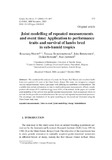| dc.contributor.author | Nguti, Rosemary | |
| dc.contributor.author | Burzykowski, Tomasz | |
| dc.contributor.author | Rowlands, John | |
| dc.contributor.author | Renard, Didier | |
| dc.contributor.author | Janssen, Paul | |
| dc.date.accessioned | 2013-03-19T16:22:45Z | |
| dc.date.available | 2013-03-19T16:22:45Z | |
| dc.date.issued | 2005-03-15 | |
| dc.identifier.citation | Genetics Selection Evolution. 2005 Mar 15;37(3):175-197 | |
| dc.identifier.uri | http://dx.doi.org/10.1186/1297-9686-37-3-175 | |
| dc.identifier.uri | http://erepository.uonbi.ac.ke:8080/xmlui/handle/123456789/14784 | |
| dc.description.abstract | Abstract
We considered the analysis of a study for Dorper, Red Maasai and crossbred lambs born over a period of 6 years at the Diani Estate, Kenya. The study was designed to compare survival and performance traits of genotypes with differing susceptibilities to helminthiasis. The available data include information on time to death and repeated measurements of body weight, packed cell volume (PCV) and faecal egg count (FEC) of the animals. In the paper, we consider joint modelling of the survival time and the repeated measurements. Such an approach allows to account for the possible association between the survival and repeated measurement processes. The advantages and limitations of the joint modelling are discussed and illustrated using the Diani Estate study data. | |
| dc.title | Joint modelling of repeated measurements and event time: Application to performance traits and survival of lambs bred in sub-humid tropics | |
| dc.type | Journal Article | |
| dc.date.updated | 2013-03-19T16:22:45Z | |
| dc.description.version | Peer Reviewed | |
| dc.language.rfc3066 | en | |
| dc.rights.holder | Rosemary Nguti et al.; licensee BioMed Central Ltd. | |

